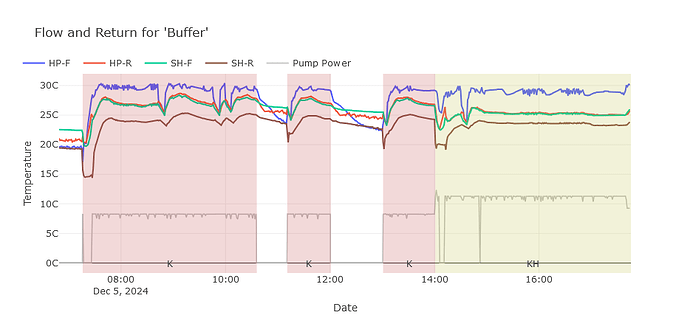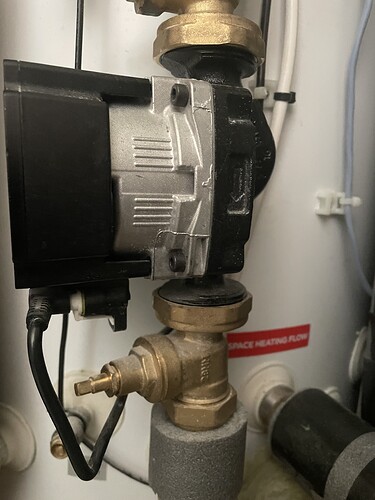I have been looking at the water flow and return temperatures on the 4-pipe buffer which forms part of the Manchester-made WorldHeat pre-plumbed cylinder which is installed with a Daikin EDLA. Something is quite wrong so I am seeking other people with the same hardware to “compare notes” with a view to finding out whether there is something wrong with the install, manufacture of my tank, or the fundamental buffer design in these units.
The buffer appears to be plumbed in correctly. Reading from left to right around the base, where the pipes exit, the order is Heat Source Return, Space Heating Return, Space Heating Flow, Heat Pump Flow. This matches the picture in the installation manual. The body of the secondary circulation pump has an arrow cast into it showing flow is indeed into the SH return. When I got the cylinder, however, the pump was on back-to-front (pumping water out of the SH return pipe!) but I spotted this and got the installer to reverse it.
The issue is that, having monitored the water temperatures (from the outside using DS18B20 devices cable-tied to the pipe, with some thermal paste and surrounded by several turns of fleece fabric for insulation), I can see the water which leaves the SH flow is the same temperature as the HP return. A typical approximate reading for “heating on” would be HP flow 32C, HP return and SH flow 28C, SH return 25C. This is clearly BAD; I’m paying a COP penalty for heating the water to 32C whereas heating to 28C would be sufficient for the same space heating, given an ideal buffer tank. This situation persists for a range of pump speeds (my original plan was to monitor the temperatures so that I could modulate the secondary pump to properly balance the buffer tank).
It looks like either the HP or SH pipes are transposed.
SO… I am looking for evidence:
A. Does my arrangement of 4 pipes exiting the buffer match yours?
B. Which direction is your secondary (space heating) circulation pump (arrow on metal body)?
C. Do you have any temperature readings? All 4 pipes at the buffer would be best (either using a similar sensor setup to me, or maybe an infra-red remote temp meter would do). Alternatively, do you have evidence that the space heating flow temperature is close to, or far from, the leaving water temperature reported by the heat pump?
In spite of this issue, the heat pump appears to be behaving itself, with longish periods of steady energy input (SMD120 feeding my Open Energy Monitor). Its attempt to maintain its flow-return dT is, of course, unhelpfully suppressing my emitter temperature!
Thanks in advance, Adam

